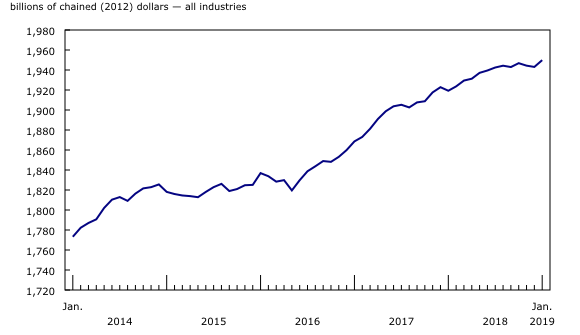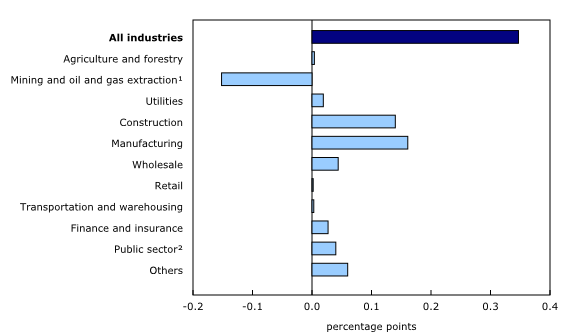Gross domestic product by industry, January 2019
Archived Content
Information identified as archived is provided for reference, research or recordkeeping purposes. It is not subject to the Government of Canada Web Standards and has not been altered or updated since it was archived. Please "contact us" to request a format other than those available.
Released: 2019-03-29
January 2019
0.3% 
(monthly change)
Real gross domestic product expanded 0.3% in January, fully offsetting the declines in November and December 2018. The rise was widespread as 18 of 20 industrial sectors were up.
On a three-month rolling average basis, real gross domestic product edged up 0.1%, the same rate as the three-month rolling average in December 2018.
The output of goods-producing industries increased 0.6%, led by growth in manufacturing and construction. Services-producing industries rose 0.2% as all but one sector increased.
Manufacturing expansion more than offsets last two monthly declines
The manufacturing sector rose 1.5% in January, more than offsetting the declines of the previous two months. The growth was widespread across subsectors as both non-durable and durable manufacturing rose.
Non-durable manufacturing's largest monthly growth rate in seven months (+1.9%) nearly offset the declines of the previous four months. The growth in January was broad based with seven of nine subsectors expanding, led by food (+2.8%), petroleum and coal products (+3.8%) and chemical (+1.9%) manufacturing.
Durable manufacturing rose 1.2% as 7 of 10 subsectors were up. Transportation equipment manufacturing led the growth (+2.5%) with widespread gains in most subsectors. Electrical equipment manufacturing was up 7.1%, the second monthly increase and the largest since January 2002, with notable increases in all subsectors.
Construction grows for the first time in eight months
Following seven months of decline, the construction sector expanded 1.9% in January. This was the largest monthly growth since July 2013, with all types of construction activity increasing.
The residential construction subsector rose 3.1%, the second consecutive monthly gain. There was continued growth in home alterations and improvements, multi-unit housing construction and a pick-up in single and semi-detached housing construction.
Following five consecutive monthly declines, non-residential construction (+0.7%) increased for the second month, led by gains in industrial, commercial and wholesale construction.
Engineering and other construction (+1.7%) was up for the first time in 14 months while repair construction rose 1.2%
Wholesale trade rises, retail trade stays flat
Wholesale trade was up 0.8% in January with seven of nine subsectors increasing. Building materials and supplies (+2.2%), personal and household goods (+2.2%) and machinery, equipment and supplies wholesaling (+0.9%) led the growth.
Retail trade was essentially unchanged in January. Increases in 9 of 12 subsectors, led by clothing and clothing accessories (+1.2%), gasoline stations (+1.3%) and building materials and garden equipment and supplies stores (+0.9%), were offset by declines at general merchandise stores (-2.5%) and motor vehicle and parts dealers (-1.0%).
The decline in mining, quarrying and oil and gas extraction continues
Mining, quarrying and oil and gas extraction was down for the fifth consecutive month in January, contracting 3.1% as all subsectors declined.
Oil and gas extraction fell 2.6% as all types of extraction were down in January. Oil sands extraction (-4.1%) was down for a third consecutive month, partly as a result of the Government of Alberta's imposition of a temporary cut in oil production starting in January 2019. This also influenced the 1.2% decline in oil and gas extraction (except oil sands), which was partly offset by the continued ramp up in production in Newfoundland and Labrador, following weather-induced shutdowns and maintenance in late 2018.
Mining (except oil and gas) declined 4.0%. Non-metallic mineral mining was down 5.4% in January, following two months of growth, largely due to a 5.4% contraction in potash and an 11.7% decrease in other (except potash) non-metallic minerals mining. Metal ore mining was down 3.9% as mining activities decreased in most subsectors. Coal mining expanded 4.8%.
Following a 17% decrease in December, support activities for mining and oil and gas extraction were down 3.9% in January as all types of supporting activities declined.
Other industries
Real estate, rental and leasing grew 0.4%. Activity at offices of real estate agents and brokers increased 4.1% in January following four months of decline, as housing resale activity rose in the majority of Canadian markets.
The public sector edged up 0.2%, with all three components (education, health care and public administration) rising.
The finance and insurance sector grew 0.4%, led by a 1.1% increase in financial investment services. Depository credit intermediation (+0.4%) was up while activity at insurance carriers and related activities was essentially unchanged.
Professional, scientific and technical services rose 0.3% in January with gains in most subsectors.
Utilities were up 0.8% after a 2.1% decline in December, as temperatures were closer to seasonal trends in most of the country.
Accommodation and food services were down 0.5%, as an increase in accommodation services was fully offset by a decrease in food services and drinking places.
Transportation and warehousing edged up 0.1% in January, as its nine subsectors were relatively evenly split between increases and declines.
Sustainable Development Goals
On January 1, 2016, the world officially began implementation of the 2030 Agenda for Sustainable Development—the United Nations' transformative plan of action that addresses urgent global challenges over the next 15 years. The plan is based on 17 specific sustainable development goals.
The release on gross domestic product by industry is an example of how Statistics Canada supports the reporting on the Global Goals for Sustainable Development. This release will be used in helping to measure the following goal:

Note to readers
The monthly GDP by industry data at basic prices are chained volume estimates with 2012 as the reference year. This means that the data for each industry and each aggregate are obtained from a chained volume index multiplied by the industry's value added in 2012. The monthly data are benchmarked to annually chained Fisher volume indexes of GDP obtained from the constant-price supply and use tables (SUT) up to the latest SUT year (2015).
For the period starting with January 2016, data are derived by chaining a fixed-weight Laspeyres volume index to the prior period. The fixed weights are 2015 industry prices.
This approach makes the monthly GDP by industry data more comparable with expenditure-based GDP data, which are chained quarterly.
All data in this release are seasonally adjusted. For information on seasonal adjustment, see Seasonally adjusted data – Frequently asked questions.
For more information on GDP, see the video "What is Gross Domestic Product (GDP)?"
Revisions
With this release of monthly GDP by industry, revisions have been made back to January 1997.
Each month, newly available administrative and survey data from various industries in the economy are integrated and result in statistical revisions. Updated and revised administrative data (including taxation statistics), new information provided by respondents to industry surveys, and standard changes to seasonal adjustment calculations are incorporated with each release.
Real-time table
Real-time table 36-10-0491-01 will be updated on April 15.
Next release
Data on GDP by industry for February will be released on April 30.
Products
The User Guide: Canadian System of Macroeconomic Accounts (13-606-G) is also available.
The Methodological Guide: Canadian System of Macroeconomic Accounts (13-607-X) is also available.
Contact information
For more information, contact us (toll-free 1-800-263-1136; 514-283-8300; STATCAN.infostats-infostats.STATCAN@canada.ca).
To enquire about the concepts, methods or data quality of this release, contact Ederne Victor (613-863-6876), Industry Accounts Division.
- Date modified:




